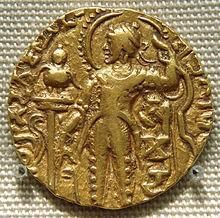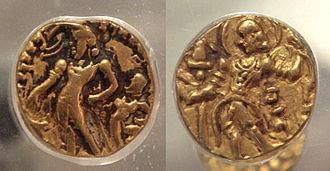The Age of the Guptas Chapter Notes | History Class 9 ICSE PDF Download
| Table of contents |

|
| The Gupta Empire |

|
| Sources |

|
| Gupta Kings |

|
| Administration under the Guptas |

|
| Progress in Science and Authority during the Gupta Period |

|
| Art and Architecture |

|
The Gupta Empire
Step into the dazzling world of the Gupta Empire, often hailed as the 'Golden Age' or 'Classical Age' of Indian history, spanning from AD 320 to AD 540. This era shines with remarkable achievements in art, science, and literature, creating a legacy that still captivates us today. From the poetic brilliance of Kalidasa to the scientific insights of Aryabhatta and the architectural marvels like the Vishnu Temple at Deogarh, the Guptas fostered a period of cultural and intellectual prosperity. These notes will guide you through the empire’s rulers, administration, and extraordinary contributions, painting a vivid picture of a time when India flourished as a beacon of progress and creativity.
- Ruled from AD 320 to AD 540, uniting North Indian territories for over a century.
- Smaller than the Mauryan Empire but politically significant.
- Known as the 'Classical Age' or 'Golden Age' of Indian history due to its cultural and intellectual achievements.
Sources
Information comes from literary and archaeological sources.
Literary Accounts
- Include Dharmashastras, Puranas, Smritis, religious texts, and travel accounts of Chinese pilgrims Fa-hien, I-tsing, and Hiuen Tsang.
Accounts of Fa-hien
- Chinese pilgrim who visited India during Chandragupta II’s reign on a religious mission.
- Travelled to Mathura, Kannauj, Kapilavastu, Kushinagar, Vaishali, Pataliputra, Kashi, and Rajagriha.
- Noted Magadha’s prosperity, large towns, and wealthy yet simple-living people following Buddhist conduct.
- Observed peaceful coexistence of Vaishnavism, Shaivism, Buddhism, and Jainism.
- Described a mild penal code with offenses usually punished by light fines.
Accounts of Hiuen Tsang
- Chinese Buddhist who visited India in AD 630 during King Harsha’s reign.
- Reported that Harsha personally oversaw administration and introduced welfare measures.
- Land revenue was the main income source, with moderate taxes.
- Noted a rigid caste system with four main castes and several subcastes.
- People led simple, pure, and chaste lives.
- Women had freedom of movement without purdah; child marriage was common.
Kalidasa
- Greatest poet of the Gupta Period, known for works like Ritusamhara, Raghuvamsa, Meghaduta, and Kumarasambhava.
- Works translated into major world languages.
- Provide reliable information on government, society, and religion, with traces of political history.
Archaeological Sources
- Include Allahabad Pillar inscription, Mathura stone inscription, Udayagiri cave inscription, temples, forts, stupas, and coins.
- Offer insights into conditions during the Gupta Period.
The Allahabad Pillar Inscription
- Contains a prashasti (eulogy) by Harishena praising Samudragupta.
- Lists kingdoms and tribal republics conquered by Samudragupta.
- Names kings ruling India in the first half of the 4th century AD.
The Vishnu Temple at Deogarh
- Located 112 km from Jhansi, Uttar Pradesh, built entirely of stone.
- Outer walls decorated with Ramayana scenes; entrance and pillars feature paintings and carvings.
- Showcases Gupta dynasty craftsmanship.
Nalanda University
- Famous educational institution in Rajagriha, Bihar, founded by Sakraditya in the 5th century AD under Kumaragupta I.
- Attracted students from Korea, Ceylon (Sri Lanka), Japan, Mongolia, China, and Tibet.
- Offered subjects like logic, grammar, medicine, samkya, yoga, Vedas, sciences, and mathematics.
- Destroyed by Ikhtiyar Khalji in the 12th century AD.
- Reflects the high educational standards of the Gupta Period.
- Example: A student at Nalanda University might study mathematics under a scholar like Aryabhatta, learning to calculate the circumference of a circle, which was a groundbreaking concept for that time.
Gupta Kings
- Founded by Srigupta around AD 240, succeeded by his son Ghatotkacha.
- Limited reliable sources exist for early Gupta history.
Chandragupta I
- One of the greatest Gupta rulers, took the title maharajadhiraja (king of kings).
- Expanded the empire through matrimonial alliances, marrying Lichchavi princess Kumaradevi.
- Conquered and annexed many territories.

Samudragupta
- Succeeded Chandragupta I, ruled from AD 335 to AD 375.
- Empire spanned from River Brahmaputra (east) to Yamuna and Chambal (west), Himalayas (north) to River Narmada (south).
- Known as the ‘Napoleon of India’ for his bravery and leadership.
- Defeated Naga kings of Mathura, Gwalior, and Ahichhatra.
- Conquered southern states but allowed them to rule under his sovereignty.
- Allahabad Pillar inscription details four types of kingdoms during his reign:
- Defeated nine Aryavrata rulers, annexing their territories.
- Defeated twelve Dakshinpatha kings, allowing them to rule.
- Assam, coastal Bengal, Nepal, and northwest republics paid tribute, followed orders, and attended his court.
- Performed ashvamedha yajna (horse sacrifice), as noted by court poet Harishena.
- Skilled musician and poet, issued eight types of gold coins.
Chandragupta II or Vikramaditya
- Known as Vikramaditya, continued his father’s expansion policy.
- Defeated the Sakas, capturing Cambay (Khambhat), Bharuch, and Sopara, earning the title Sakari (conqueror of Sakas).
- Occupied Saurashtra and Malwa, gaining access to western ports for trade with Europe via Egypt.
- Formed a matrimonial alliance with the Naga family.
- His daughter Prabhavati’s marriage to a Vakataka ruler extended influence in the Deccan.
- Patronized art and literature, hosting scholars like Kalidasa and Amarasimha at his Ujjain court.
- Fa-hien visited during his reign, documenting society.
- Issued various gold coins; his court featured the ‘nine gems’ (scholars like Kalidasa, Varahamihira, and Amarasimha).

Kumaragupta
- Succeeded Chandragupta II in AD 414.
- Faced the first invasion by the Huns, a Central Asian barbarian tribe.
- Huns later attacked during Skandagupta’s reign and were defeated.
Administration under the Guptas
- Republican kingdoms (gana sanghas) declined during the Gupta Period.
Kings were seen as divine, compared to gods like Yama, Varuna, Indra, and Kubera. Administration was highly centralized, with the emperor holding political, economic, military, and judicial powers. Kings appointed key administrative and military officers and governors, who worked under their supervision. Brahmins held important court positions, acting as custodians and interpreters of laws, checking royal power.
Consisted of royal princes, high officers, and feudatories. Included Kumaramatyas and sandhivigrahika (minister of war and peace, managing relations with feudatories). Shaulkika handled toll collection on commodities. Revenues were mostly collected in kind, but rich peasants paid in cash.
Empire divided into provinces called Bhuktis, managed by governors (Uparika). Bhuktis subdivided into districts (Vishayas), overseen by Vishyapati. Prominent cities managed by Ayukats. Villages run by a headman with help from village elders. Vithis handled local land transactions. Towns administered by a five-member committee led by a Purpala. Artisans and craftsmen formed guilds called Kulika; merchants organized as Shreshthi.
- High officers received land grants instead of cash, marking the start of feudalism.
- State authority devolved, with functions like law enforcement, tax collection, defense, and mine regulation shifting to warriors and local authorities.
Progress in Science and Authority during the Gupta Period
- Notable for advancements in science and technology.
- Aryabhatta, a mathematician and astronomer, wrote Aryabhattiyam and Surya Sidhanta, stating Earth revolves around the Sun, providing rules for circle circumference, and explaining eclipses scientifically.
- Varahamihira’s Panch Sidhantika and Brihat Samhita proved the Moon orbits Earth and Earth orbits the Sun, studying planetary movements.
- Brahmagupta’s Brahma Sphutic Siddhanta described gravity centuries before Newton.
- Indian numerals (1–9) spread to Arabs and Europe; the concept of zero was invented in India.
- Medicine advanced through Charaka (Charaka Samhita) and Sushruta (Susruta Samhita), experts in Ayurveda and cosmetic surgery, respectively; Dhanvantari was a general physician.
- Metallurgy reached high levels, exemplified by the non-rusting Iron Pillar at Mehrauli near Qutub Minar.
- Gold and silver coin minting showed advanced metal casting skills.
- Example: Aryabhatta’s discovery that Earth revolves around the Sun could have helped Gupta astronomers predict seasons accurately, aiding farmers in planning crop cycles.
Art and Architecture
Temples built on raised platforms using brick and stone. Sanctum sanatoriums had flat roofs; some temples had a second storey above the shrine. Outer walls richly carved; temples were square with low shikara. Notable examples: Brick Temple at Bhitargaon (Kanpur), Deogarh Temple (Jhansi), and Bhitari Temple (Gazipur). Many stupas, viharas, and chaityas were constructed.

Evolved from Mathura and Sarnath schools of art; Pataliputra later emerged as a third school. Artists focused on plain and folded drapery. Deity halos became ornamented, unlike earlier styles. Buddha depicted with curly hair, differing from Gandhara art’s style.
Reached high excellence, especially in Ajanta, Ellora, and Bagh caves. Used vegetable dyes and natural colors (white, green, yellow, blue, black). Depicted scenes from Buddha’s life and Jataka Tales.
Literary Arts
Sanskrit became the official language for inscriptions and documents, boosting classical Sanskrit literature.Notable works:
- Kalidasa’s plays Abhijnan Shakuntalam and Meghdootam.
- Vishakhadatta’s Mudrarakshasa, portraying Chandragupta as a great king.
- Harishena’s prashasti for Samudragupta; Bhasa’s 13 plays based on Ramayana and Mahabharat.
- Dandin’s Kavyadarsha and Dasakumaracharita; Subandhu’s Vasavadutta.
- Bhairavi’s Kiratarjuniya, depicting Kirat and Arjuna’s battle.
- Vishnusharma’s Panchtantra, a collection of stories with moral themes.
- Fa-hien’s glowing account of the Gupta kingdom.
- Banabhatta’s Harshacharita, written post-Gupta for Harshavardhana.
- Manusmriti and Puranas (including Bhagvata Purana) with philosophical doctrines.
The Gupta Period’s political unity and advancements in science, art, and literature earned it the title ‘Golden Age’ or ‘Classical Age’.
|
14 videos|59 docs|16 tests
|



















